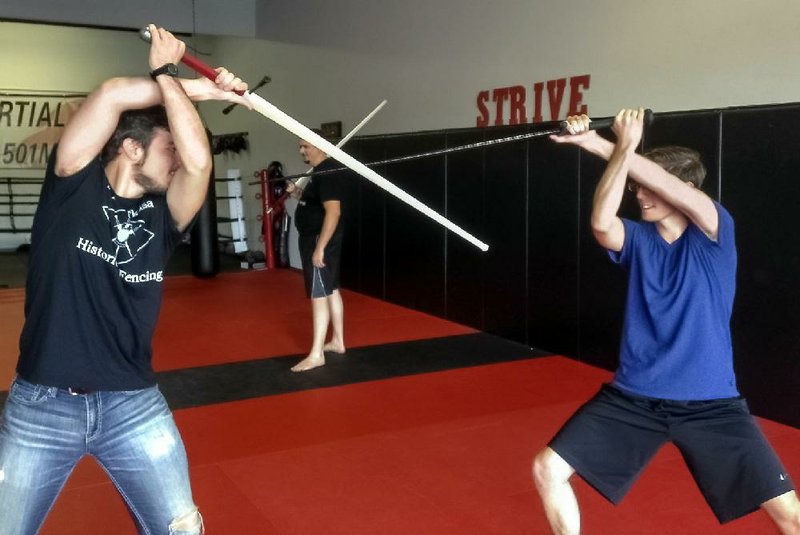Think about fencing and perhaps the first image that pops into mind is of people in mesh-faced masks and padded white outfits yelling "En garde!" and trying to poke each other with floppy foils.
This is not that kind of fencing. This is fencing with a dose of European medieval and Renaissance history on the side as eight members of the Central Arkansas Historical Fencing (CAHF) club gather in Conway for a two-hour practice session.
What: Central Arkansas Historical Fencing
When/Where: Practice sessions are 6-8 p.m. Wednesday, Murray Park, Rebsamen Park Road, Little Rock, and 1-3 p.m. Saturday, 501 Martial Arts, 2585 Donaghey Ave., Conway.
Why: To scratch that sword-swinging, history-loving itch
How: Search Facebook for Central Arkansas Historical Fencing or visit hemaalliance.com.
"This is basically fencing from when it was still a martial art," says instructor Kenneth Marcrum of Sherwood.
Hang on. Martial arts? In Europe?
"Most people don't know that Europe had a strong martial arts tradition," Marcrum, 42, says. "Asian martial arts did much better in holding on to their traditions than the Europeans did."
Before sword fighting faded away in places like Italy and Germany, there were masters who wrote down, and in some cases illustrated, their techniques and forms; it is from these writings that clubs like CAHF learn how it was done way back in the day.
The group is affiliated with the Historical European Martial Arts Alliance (HEMAA), which provides access to the old manuscripts that have been translated and put online for clubs and long-sword-fighting enthusiasts.
"The purpose for that is to help bring these martial arts back," says Marcrum, who also participates in karate, jujitsu and other combat sports. "[HEMAA] wants to get as many eyes on them as possible."
Marcrum talks while leading fellow club members through warm-up exercises at Conway's 501 Martial Arts, the group's Saturday afternoon practice space. There are also practices on Wednesday evenings at Murray Park in Little Rock.
"What's not to love about swords," asks Jessica LaVergne, a 24-year-old CAHF member and self-confessed "martial arts nerd" from Little Rock, after pulling off her fencing mask following a sparring session.
LaVergne and the other fencers are working on sword-fighting drills with plastic long swords called synthetics. Their clacking and smacking sounds fill the stuffy room, which has a padded floor and wall as well as a mirror on one wall, a boxing ring and heavy bag at the back. Steel swords with blunted tips are also used, but at the practice, the synthetics are the ones getting the most use.
"It's a lot more technical and a lot less flashy than the stuff you see in the media," says Dylan Clarke, when asked what he likes most about historical fencing. "It's direct. It's action-packed. It requires a lot of discipline."
And speaking of discipline, there is a competitive side to the sport. Some CAHF members will travel to Houston for a tournament later this month to cross swords with fellow historical fencers.
"The [Olympic] sport of fencing is very linear," Marcrum says, when comparing the two. "They go back and forth in a lane and have a lot of rules."
He says historical fencing tournaments, however, have less rules and are a bit more combative: "Even in our tournaments, grappling is allowed. Kicking is allowed."
Ouch.
There's a concentrated effort by HEMAA, though, to keep historical fencing tilted more toward history than spectacle, Marcrum says. "That's the H in HEMAA. You have to take it back to the source."
Curious?
"All you've got to do is show up" at a practice, Marcrum says. No need to invest in special gear -- a mask, padded gloves, shin guards and, of course, a sword -- at first. He keeps extra equipment handy for folks who drop by for a look-see. If you join the group, dues are $20 a month, with the first two weeks of the first month free.
Let's Do This is an occasional column of things to do off the beaten path. Have a suggestion? Email:
Style on 10/11/2016

